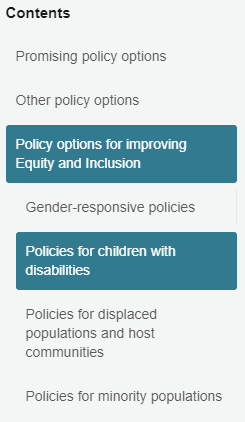The best education policies are those that are relevant to local contexts and fit for the purpose at hand. A policy that is cost-effective in one context might not be in another, and a policy relevant in the 1990s might no longer be… and the opposite is also true.
As educational planners, policy-makers, and managers know, it is very difficult to design effective policies from scratch. For this reason, The Education Policy Toolbox was created to provide an international perspective on how government address similar issues with different policy responses.
The Education Policy Toolbox is an online catalogue of more than 500 education policy options, sourced from over 900 papers and reports, which address the bottlenecks of educational inequality. It has been developed by the UNESCO International Institute for Educational Planning (IIEP) to contribute to the use of evidence for informed policy- and decision-making. These policy options address 49 key educational challenges and include customized content related to marginalized populations. The policy options (and their bibliographic references) are designed to guide policy responses to issues related to student completion, student learning, and equity and inclusion.
The navigation through the topics and ultimately to the policy options is designed as decision trees that can be complemented by different sources of evidence (EMIS data, special surveys, inspection reports) to decide on which pathway to continue the identification of constraints.

The Education Policy Toolbox was developed out of an IIEP technical cooperation project, the Policy Tree, an offline, PowerPoint application that allows a group of education planners, managers, and stakeholders to engage in constructive dialogue around challenges identified in an education sector analysis (ESA), in order to prioritize issues to include in the education sector plan (ESP) design. The work done using the Policy Tree, typically facilitated by IIEP staff, culminates in the production of a memo, which captures the different pathways identified from issue to bottlenecks, and documents the discussions, data sources and knowledge gaps that will inform policy. The memo also summarizes the different policy options extracted from the Policy Toolbox.
The Education Policy Toolbox can be searched in two ways: using the interactive search bar, or by navigating the three thematic areas Access & Completion, Learning Process, and Equity & Inclusion.
Acknowledgements
The policy summaries were prepared by a group of consultants composed of Juana Barragán Díaz, Tuamanaia Foimapafisi, Clara Galea, and Hannah Maddrey, under the direction and supervision of Hugues Moussy, Team Leader Research and Development at IIEP, and Amélie A. Gagnon, Senior Programme Specialist leading the Development Unit. We are grateful to IIEP colleagues Germán Vargas Mesa and Rowaida Khaled for developing the platform and meticulously reviewing each page, and to Lynne Sergeant for her inputs.
The Education Policy Toolbox was piloted with a group of planning professionals around the world and we are grateful for the in-depth feedback from:
Adama Jean Momoh, Director of Planning and Policy, Ministry of Basic and Senior Secondary Education, Sierra Leone
Alexandra Draxler, Senior Advisor, NORRAG- the Network for international policies and cooperation in education and training
Alfred K Phelefu, Education Officer, Ministry of Education, Botswana
D.H.M. Peshala S. Dissanayake, Assistant Director of Education (Planning), North Western Provincial Department of Education, Sri Lanka
Ekitoe Paul, Principal Quality Assurance & Standards Officer, Ministry of Education, Kenya
Gita Steiner-Khamsi, Professor of Comparative and International Education at Teachers College, Columbia University and her class of Fall 2019 students
Jane Nakajubi, Acting Senior Economist, Ministry of Education and Sports, Uganda
Mohamed Mukhtar, ESA/ESSP Consultant at Ministry of Education, Culture and Higher Education, Somalia
Rabson Jim Papa Madi, Monitoring and Evaluation Officer, Directorate of Teacher Education and Development (DTED), Ministry of Education, Malawi
Siajabu Suleiman Pandu, Director of Personnel and Human Resources, Second Vice President’s Office, Zanzibar
Susan Wangari Ngigi, Principal Education Officer, Ministry of Education, Kenya
We are also grateful to IIEP colleagues Laura Paviot, Ieva Raudonyte, Marcelo Souto Simao, and Alexandra Waldhorn for their contribution to the pilot.
How to use this tool? The Search bar

The search bar uses a Google-type search. Type the subject you are interested in in the search bar and related policy boxes will appear for you to choose from. Scroll down the results to click on the issue you are searching for or press Enter to obtain a full list of results.

Navigating the thematic areas
Below the search bar are three main education challenges: Access & Completion, Learning Processes, and Equity & Inclusion. This advanced search will allow you to work backwards from key system outcomes (low levels of completion, low levels of learning and equity issues), to systematically identify the key constraints at the root of these challenges.
Steps 1 to 3 describe how to navigate and diagnose the issues.

Step 1: Determine the key outcome
Start your navigation by identifying the issue you want to improve. For example, choose “Access & Completion” as an outcome you want to improve.
Step 2: Why are there low completion rates?
Low completion rates may be due to students who can’t access school, or students who drop-out or are pushed out before they finish their education. In a context where Access to education is already high, access might not be the cause of low completion rates. Click on Drop-out/push-out to resume your navigation and identify further constraints.
Step 3: What factors explain “Drop-out/push-out”?
After clicking on “Drop-out/push-out” box, factors such as “Supply” and “Instruction and learning obstacles” appear along with policy pages. You can narrow your search further to explain why school “supply” is insufficient. Policy pages such as “Availability of last grades” or “Frequent repetition” are considered the final step of your search. When you click on the term, you will reach the final policy page of specific topics.
The Policy page
The Policy page provides different sets of policy options that can respond to the issue. The policy options are divided into:
- Promising policy options: tried and tested options, yielding the expected results as a long-term policy.
- Other policy options: temporary options, useful for the short-term, but not proven sustainable options.
- “Policy options for improving equity and inclusion”: policy options for marginalized groups.
Contents

Each policy page has a contents box on the left-hand side. This box lists all the policy options related to the policy page. The contents box is interactive. As you scroll down the page and pass through the different policy options, the different policy options will appear on the right-hand side of the page.
References

After each set of policy options is a “References” box containing bibliographic references of the literature consulted along with hyperlinks to access the full-text resource. Click on the plus sign to see the corresponding references.
The Education Policy Toolbox also contains a Glossary which provides a list of terms used in the policy boxes along with their definitions. When you hover on the underlined words, a definition will appear as a tooltip (for example, hover your mouse over Monitoring). Click on the underlined word to consult the definition and its references.
The full list of bibliographic references can be accessed here.
Disclaimer
The pages under the thematic area “Equity and Inclusion” are still under expert review and are available here in beta format.
